Analysis of Renewable Energy Projects in Saudi Arabia and Iran
VerifiedAdded on 2020/01/23
|40
|14804
|74
Thesis and Dissertation
AI Summary
This dissertation examines the renewable energy projects and related policies of Saudi Arabia and Iran, focusing on their transition from non-renewable energy sources. The study investigates the investment strategies, technological advancements, and challenges faced by both nations in developing solar energy projects. It analyzes case studies to understand the impact of transformation policies, institutional, infrastructural, financial, and economic barriers. The research also explores the implications of this shift for OPEC and the global energy market, considering how these nations aim to maintain their dominance. The report includes a literature review, research methodology, data analysis, discussion, and conclusions with recommendations, offering insights into the future of energy production and its impact on the global economy. The dissertation highlights the importance of renewable energy in reducing pollution and ensuring sustainable energy practices.
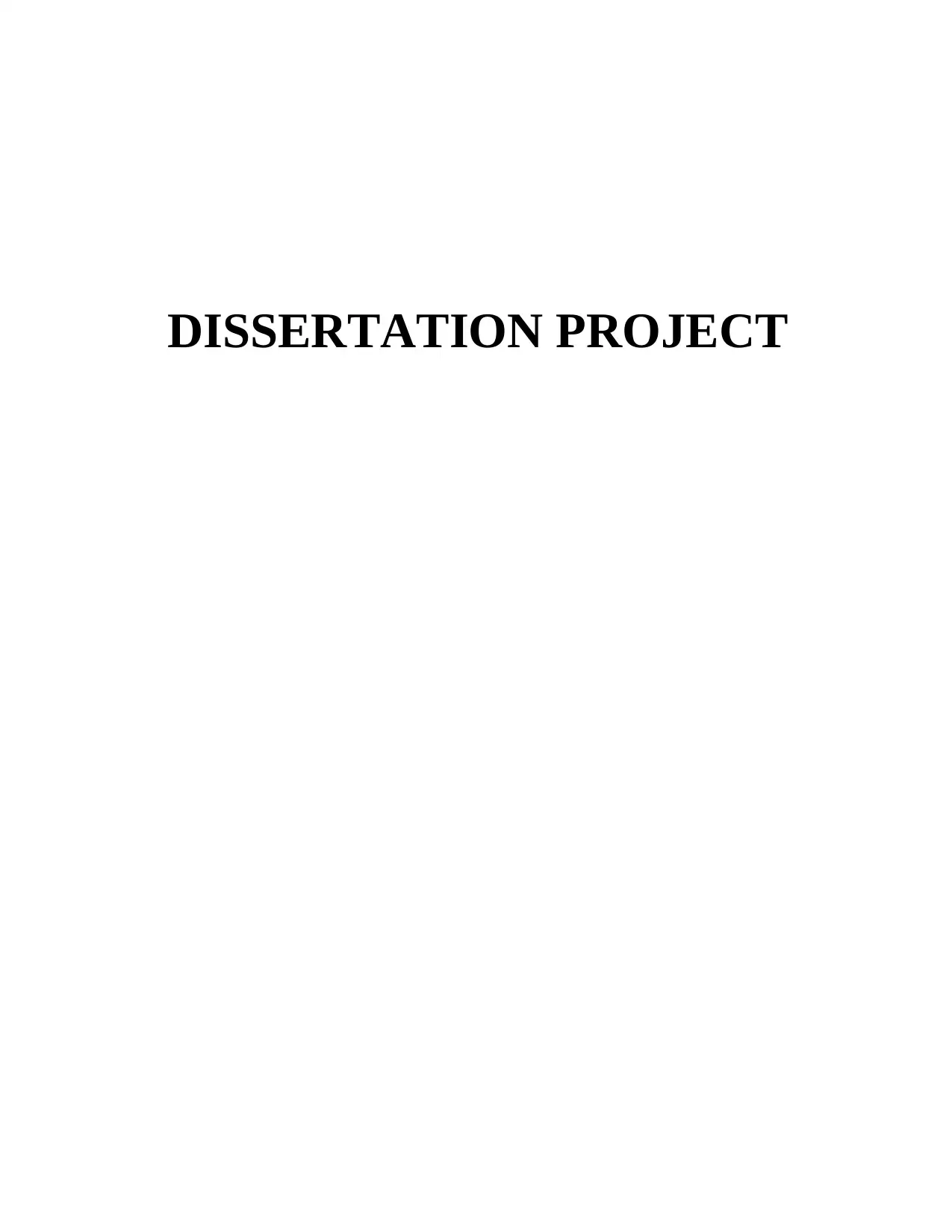
DISSERTATION PROJECT
Paraphrase This Document
Need a fresh take? Get an instant paraphrase of this document with our AI Paraphraser

ACKNOWLEDGEMENT
Dissertation is prepared on renewable energy projects and issues related to them in Saudi
Arabia and Iran. In order to complete this project extensive research is carried out on different
articles that are published on varied websites. Case studies are also analyzed in order to develop
broad understanding on research topic. During the time when I was carrying out project work
assistance from number of people was received. In this regard, I am thankful to friends for
guiding me in preparation of dissertation. I appreciate my mentor for giving lot of support in
carrying out research work. It is support of friends and mentor which help in completing my
dissertation. At last I willing to give thanks to all those who help me execution of this research
study.
Dissertation is prepared on renewable energy projects and issues related to them in Saudi
Arabia and Iran. In order to complete this project extensive research is carried out on different
articles that are published on varied websites. Case studies are also analyzed in order to develop
broad understanding on research topic. During the time when I was carrying out project work
assistance from number of people was received. In this regard, I am thankful to friends for
guiding me in preparation of dissertation. I appreciate my mentor for giving lot of support in
carrying out research work. It is support of friends and mentor which help in completing my
dissertation. At last I willing to give thanks to all those who help me execution of this research
study.
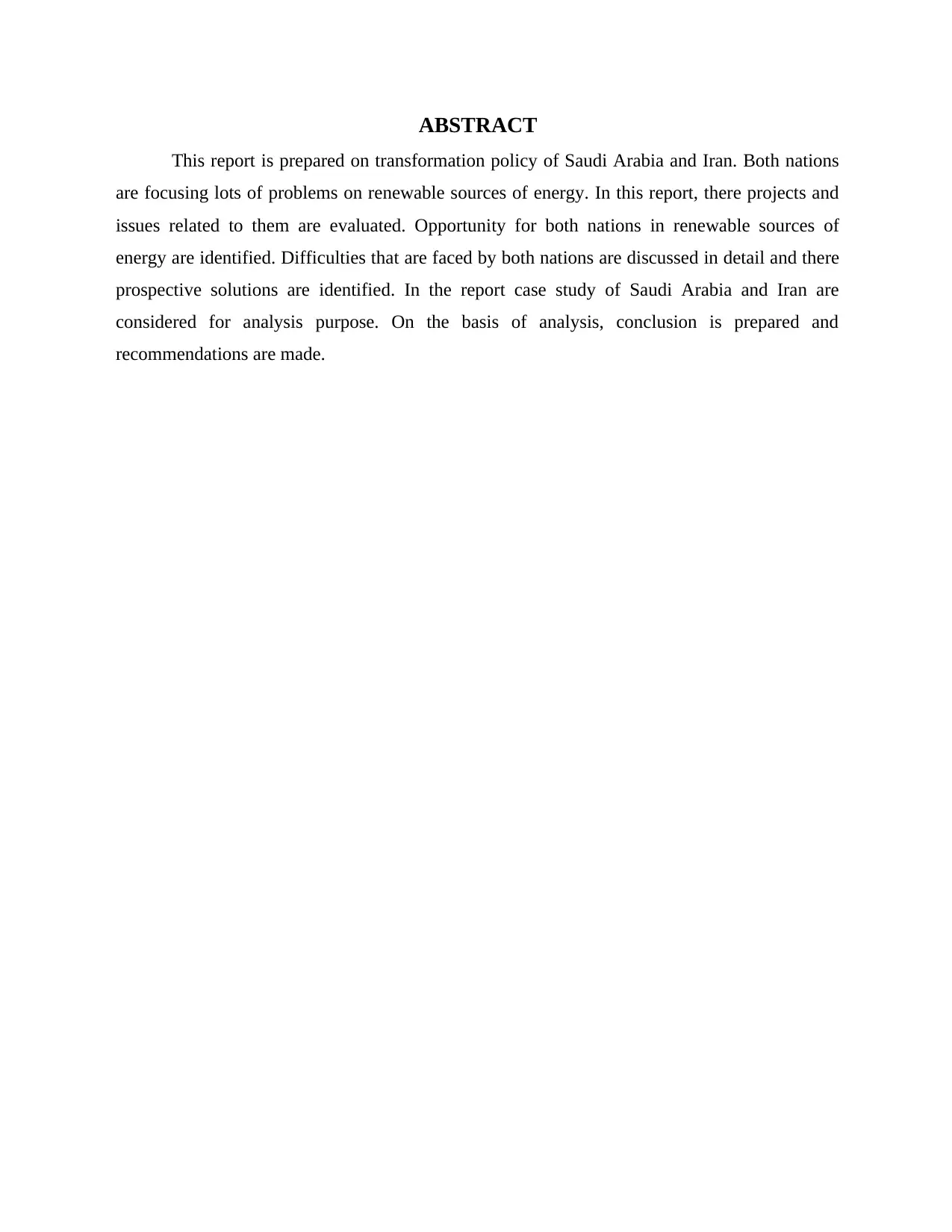
ABSTRACT
This report is prepared on transformation policy of Saudi Arabia and Iran. Both nations
are focusing lots of problems on renewable sources of energy. In this report, there projects and
issues related to them are evaluated. Opportunity for both nations in renewable sources of
energy are identified. Difficulties that are faced by both nations are discussed in detail and there
prospective solutions are identified. In the report case study of Saudi Arabia and Iran are
considered for analysis purpose. On the basis of analysis, conclusion is prepared and
recommendations are made.
This report is prepared on transformation policy of Saudi Arabia and Iran. Both nations
are focusing lots of problems on renewable sources of energy. In this report, there projects and
issues related to them are evaluated. Opportunity for both nations in renewable sources of
energy are identified. Difficulties that are faced by both nations are discussed in detail and there
prospective solutions are identified. In the report case study of Saudi Arabia and Iran are
considered for analysis purpose. On the basis of analysis, conclusion is prepared and
recommendations are made.
⊘ This is a preview!⊘
Do you want full access?
Subscribe today to unlock all pages.

Trusted by 1+ million students worldwide

TABLE OF CONTENTS
INTRODUCTION...........................................................................................................................6
1.1 Background.......................................................................................................................7
1.2 Aim & objective...............................................................................................................7
1.3 Rationale of research .......................................................................................................7
1.4 Significance of study........................................................................................................8
1.5 Structure of report ............................................................................................................8
...............................................................................................................................................9
LITERATURE REVIEW..............................................................................................................10
2.1 Solar energy projects in Iran...........................................................................................10
2.2 To identify the impact that transformation policy will put on Saudi Arabia and Iran?..11
2.3 Investment on solar projects...........................................................................................12
2.4 Technology and cost of solar projects............................................................................13
2.5 Conclusion of Literature review.....................................................................................13
RESEARCH METHODOLOGY.................................................................................................15
3.1Research introduction......................................................................................................15
3.2 Research type..................................................................................................................15
3.3 Research design .............................................................................................................15
3.4 Research approach .........................................................................................................16
3.5 Research philosophy.......................................................................................................17
3.6 Data collection methods.................................................................................................17
3.7 Data analysis...................................................................................................................17
3.8 Validity and reliability....................................................................................................17
3.9 Ethical consideration......................................................................................................18
3.10 Limitation of study.......................................................................................................18
3.11 Conclusion....................................................................................................................18
ANALYSIS...................................................................................................................................19
4.1 Case study on Saudi Arabia............................................................................................19
4.1.1 Introduction............................................................................................................19
4.1.2 Detailed analysis of case study...............................................................................19
INTRODUCTION...........................................................................................................................6
1.1 Background.......................................................................................................................7
1.2 Aim & objective...............................................................................................................7
1.3 Rationale of research .......................................................................................................7
1.4 Significance of study........................................................................................................8
1.5 Structure of report ............................................................................................................8
...............................................................................................................................................9
LITERATURE REVIEW..............................................................................................................10
2.1 Solar energy projects in Iran...........................................................................................10
2.2 To identify the impact that transformation policy will put on Saudi Arabia and Iran?..11
2.3 Investment on solar projects...........................................................................................12
2.4 Technology and cost of solar projects............................................................................13
2.5 Conclusion of Literature review.....................................................................................13
RESEARCH METHODOLOGY.................................................................................................15
3.1Research introduction......................................................................................................15
3.2 Research type..................................................................................................................15
3.3 Research design .............................................................................................................15
3.4 Research approach .........................................................................................................16
3.5 Research philosophy.......................................................................................................17
3.6 Data collection methods.................................................................................................17
3.7 Data analysis...................................................................................................................17
3.8 Validity and reliability....................................................................................................17
3.9 Ethical consideration......................................................................................................18
3.10 Limitation of study.......................................................................................................18
3.11 Conclusion....................................................................................................................18
ANALYSIS...................................................................................................................................19
4.1 Case study on Saudi Arabia............................................................................................19
4.1.1 Introduction............................................................................................................19
4.1.2 Detailed analysis of case study...............................................................................19
Paraphrase This Document
Need a fresh take? Get an instant paraphrase of this document with our AI Paraphraser

4.1.3 Some problems that are hampering growth of shifting to renewable source of energy
Institutional barrier..........................................................................................................23
4.1.4 Infrastructure barriers.............................................................................................23
4.1.5 Financial barriers....................................................................................................23
4.1.6 Economic barrier....................................................................................................24
4.2 Case study analysis on Iran............................................................................................25
4.3What does renewable energy mean for future of OPEC?................................................27
4.4 OPEC economic policy for or against renewable energy...............................................28
4.5 Conclusion of analysis section.......................................................................................29
DISCUSSION ..............................................................................................................................30
Conclusion on discussion section.........................................................................................31
CONCLUSION AND RECOMMENDATION............................................................................32
REFLECTION..............................................................................................................................36
REFERENCES..............................................................................................................................37
Institutional barrier..........................................................................................................23
4.1.4 Infrastructure barriers.............................................................................................23
4.1.5 Financial barriers....................................................................................................23
4.1.6 Economic barrier....................................................................................................24
4.2 Case study analysis on Iran............................................................................................25
4.3What does renewable energy mean for future of OPEC?................................................27
4.4 OPEC economic policy for or against renewable energy...............................................28
4.5 Conclusion of analysis section.......................................................................................29
DISCUSSION ..............................................................................................................................30
Conclusion on discussion section.........................................................................................31
CONCLUSION AND RECOMMENDATION............................................................................32
REFLECTION..............................................................................................................................36
REFERENCES..............................................................................................................................37
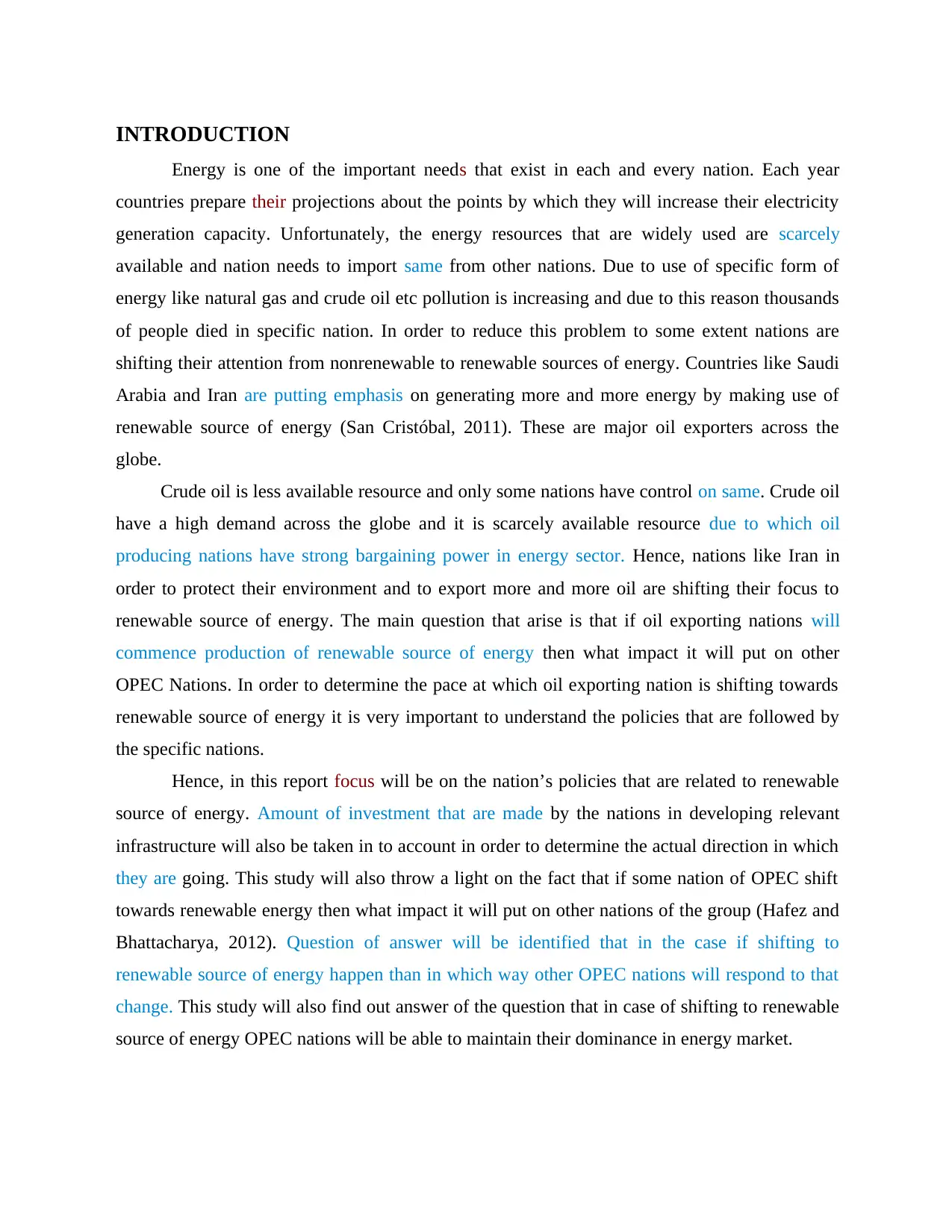
INTRODUCTION
Energy is one of the important needs that exist in each and every nation. Each year
countries prepare their projections about the points by which they will increase their electricity
generation capacity. Unfortunately, the energy resources that are widely used are scarcely
available and nation needs to import same from other nations. Due to use of specific form of
energy like natural gas and crude oil etc pollution is increasing and due to this reason thousands
of people died in specific nation. In order to reduce this problem to some extent nations are
shifting their attention from nonrenewable to renewable sources of energy. Countries like Saudi
Arabia and Iran are putting emphasis on generating more and more energy by making use of
renewable source of energy (San Cristóbal, 2011). These are major oil exporters across the
globe.
Crude oil is less available resource and only some nations have control on same. Crude oil
have a high demand across the globe and it is scarcely available resource due to which oil
producing nations have strong bargaining power in energy sector. Hence, nations like Iran in
order to protect their environment and to export more and more oil are shifting their focus to
renewable source of energy. The main question that arise is that if oil exporting nations will
commence production of renewable source of energy then what impact it will put on other
OPEC Nations. In order to determine the pace at which oil exporting nation is shifting towards
renewable source of energy it is very important to understand the policies that are followed by
the specific nations.
Hence, in this report focus will be on the nation’s policies that are related to renewable
source of energy. Amount of investment that are made by the nations in developing relevant
infrastructure will also be taken in to account in order to determine the actual direction in which
they are going. This study will also throw a light on the fact that if some nation of OPEC shift
towards renewable energy then what impact it will put on other nations of the group (Hafez and
Bhattacharya, 2012). Question of answer will be identified that in the case if shifting to
renewable source of energy happen than in which way other OPEC nations will respond to that
change. This study will also find out answer of the question that in case of shifting to renewable
source of energy OPEC nations will be able to maintain their dominance in energy market.
Energy is one of the important needs that exist in each and every nation. Each year
countries prepare their projections about the points by which they will increase their electricity
generation capacity. Unfortunately, the energy resources that are widely used are scarcely
available and nation needs to import same from other nations. Due to use of specific form of
energy like natural gas and crude oil etc pollution is increasing and due to this reason thousands
of people died in specific nation. In order to reduce this problem to some extent nations are
shifting their attention from nonrenewable to renewable sources of energy. Countries like Saudi
Arabia and Iran are putting emphasis on generating more and more energy by making use of
renewable source of energy (San Cristóbal, 2011). These are major oil exporters across the
globe.
Crude oil is less available resource and only some nations have control on same. Crude oil
have a high demand across the globe and it is scarcely available resource due to which oil
producing nations have strong bargaining power in energy sector. Hence, nations like Iran in
order to protect their environment and to export more and more oil are shifting their focus to
renewable source of energy. The main question that arise is that if oil exporting nations will
commence production of renewable source of energy then what impact it will put on other
OPEC Nations. In order to determine the pace at which oil exporting nation is shifting towards
renewable source of energy it is very important to understand the policies that are followed by
the specific nations.
Hence, in this report focus will be on the nation’s policies that are related to renewable
source of energy. Amount of investment that are made by the nations in developing relevant
infrastructure will also be taken in to account in order to determine the actual direction in which
they are going. This study will also throw a light on the fact that if some nation of OPEC shift
towards renewable energy then what impact it will put on other nations of the group (Hafez and
Bhattacharya, 2012). Question of answer will be identified that in the case if shifting to
renewable source of energy happen than in which way other OPEC nations will respond to that
change. This study will also find out answer of the question that in case of shifting to renewable
source of energy OPEC nations will be able to maintain their dominance in energy market.
⊘ This is a preview!⊘
Do you want full access?
Subscribe today to unlock all pages.

Trusted by 1+ million students worldwide

1.1 Background
Recently, Paris summit executed in which 190 countries takes a participation and all
participants agree on reducing pollution and emanation of harmful elements in natural
environment. This make inevitable for most of the nation specially OPEC nations to think about
renewable source of energy. Earlier, also these nations were producing mentioned type of energy
but same was happening at very slow pace. Now, more and more nations are exploring alternate
sources of energy to reduce their dependency on traditional nonrenewable sources of energy
(Kanase-Patil, Saini and Sharma, 2010). Hence, this report is prepared to identify the possible
changes that may happen in future time period and its impact on oil producing nations
specifically Saudi Arabia and Iran.
1.2 Aim & objective
Aims of research- The main aim of this research is to evaluate policies related to
renewable source of energy followed by Saudi Arabia and Iran as well as their impact on the
OPEC Nations in future time period.
Objective of study
To identify the extent to which transformation happened in Saudi Arabia and Iran till the
date.
To identify the impact that transformation policy will put on Saudi Arabia and Iran.
To identify the strategies that can be implemented by the nations to maintain their
dominance in the energy market when gradually transformation happens to renewable
source of energy.
To identify if oil producing nations start production of renewable energy on large scale
then in future also they will have same control on energy market.
1.3 Rationale of research
It is very important to conduct this research because currently it can be seen that with
small change in global economy price of crude oil fluctuate sharply. In future transformation
that will happen to renewable sources of energy is certain. Hence, it is very important to
understand that execution of such kind of policy to what extent will bring changes in the energy
market. It was necessary to identify that what threats and opportunities will come in existence in
the market due to commencement of transformation process across the globe in terms of energy
Recently, Paris summit executed in which 190 countries takes a participation and all
participants agree on reducing pollution and emanation of harmful elements in natural
environment. This make inevitable for most of the nation specially OPEC nations to think about
renewable source of energy. Earlier, also these nations were producing mentioned type of energy
but same was happening at very slow pace. Now, more and more nations are exploring alternate
sources of energy to reduce their dependency on traditional nonrenewable sources of energy
(Kanase-Patil, Saini and Sharma, 2010). Hence, this report is prepared to identify the possible
changes that may happen in future time period and its impact on oil producing nations
specifically Saudi Arabia and Iran.
1.2 Aim & objective
Aims of research- The main aim of this research is to evaluate policies related to
renewable source of energy followed by Saudi Arabia and Iran as well as their impact on the
OPEC Nations in future time period.
Objective of study
To identify the extent to which transformation happened in Saudi Arabia and Iran till the
date.
To identify the impact that transformation policy will put on Saudi Arabia and Iran.
To identify the strategies that can be implemented by the nations to maintain their
dominance in the energy market when gradually transformation happens to renewable
source of energy.
To identify if oil producing nations start production of renewable energy on large scale
then in future also they will have same control on energy market.
1.3 Rationale of research
It is very important to conduct this research because currently it can be seen that with
small change in global economy price of crude oil fluctuate sharply. In future transformation
that will happen to renewable sources of energy is certain. Hence, it is very important to
understand that execution of such kind of policy to what extent will bring changes in the energy
market. It was necessary to identify that what threats and opportunities will come in existence in
the market due to commencement of transformation process across the globe in terms of energy
Paraphrase This Document
Need a fresh take? Get an instant paraphrase of this document with our AI Paraphraser
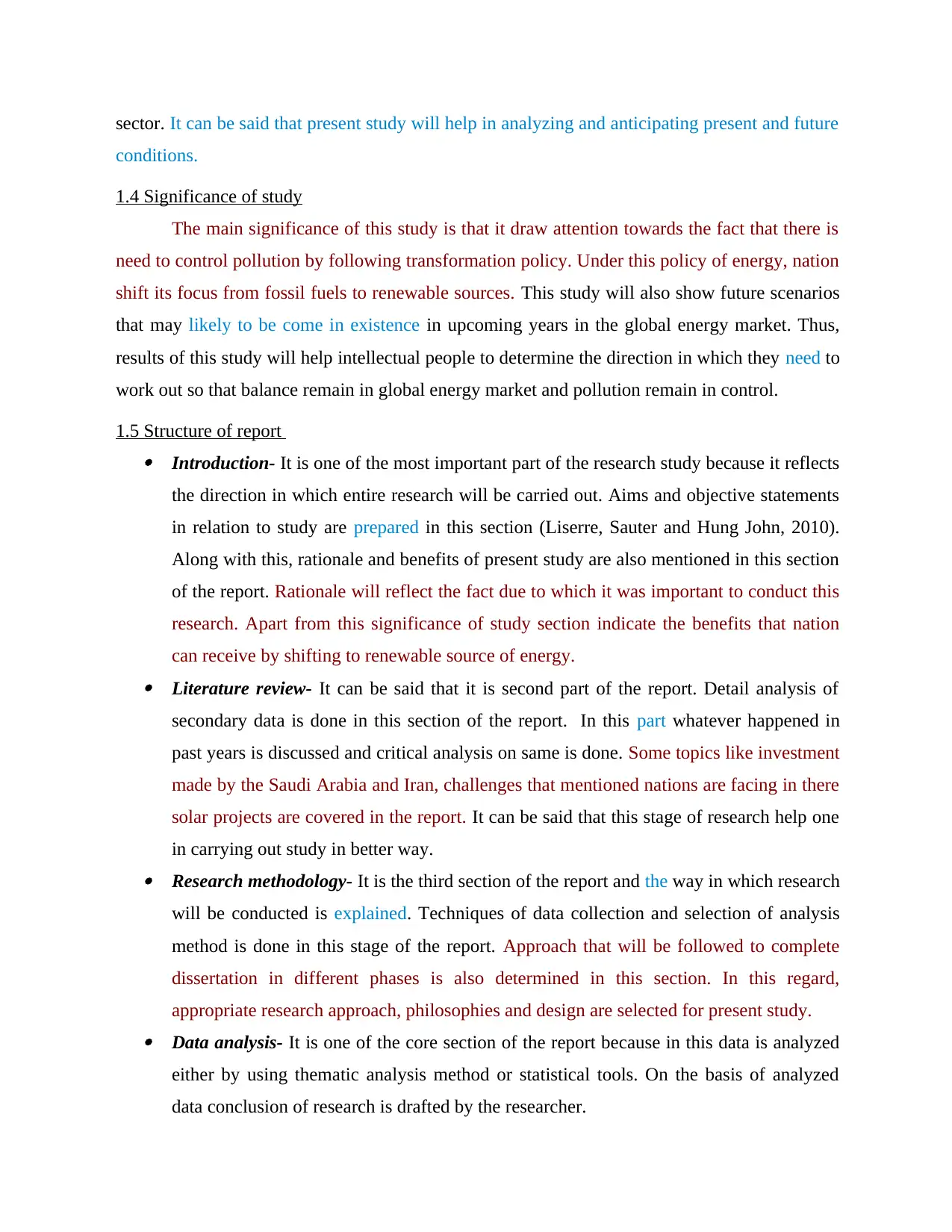
sector. It can be said that present study will help in analyzing and anticipating present and future
conditions.
1.4 Significance of study
The main significance of this study is that it draw attention towards the fact that there is
need to control pollution by following transformation policy. Under this policy of energy, nation
shift its focus from fossil fuels to renewable sources. This study will also show future scenarios
that may likely to be come in existence in upcoming years in the global energy market. Thus,
results of this study will help intellectual people to determine the direction in which they need to
work out so that balance remain in global energy market and pollution remain in control.
1.5 Structure of report Introduction- It is one of the most important part of the research study because it reflects
the direction in which entire research will be carried out. Aims and objective statements
in relation to study are prepared in this section (Liserre, Sauter and Hung John, 2010).
Along with this, rationale and benefits of present study are also mentioned in this section
of the report. Rationale will reflect the fact due to which it was important to conduct this
research. Apart from this significance of study section indicate the benefits that nation
can receive by shifting to renewable source of energy. Literature review- It can be said that it is second part of the report. Detail analysis of
secondary data is done in this section of the report. In this part whatever happened in
past years is discussed and critical analysis on same is done. Some topics like investment
made by the Saudi Arabia and Iran, challenges that mentioned nations are facing in there
solar projects are covered in the report. It can be said that this stage of research help one
in carrying out study in better way. Research methodology- It is the third section of the report and the way in which research
will be conducted is explained. Techniques of data collection and selection of analysis
method is done in this stage of the report. Approach that will be followed to complete
dissertation in different phases is also determined in this section. In this regard,
appropriate research approach, philosophies and design are selected for present study. Data analysis- It is one of the core section of the report because in this data is analyzed
either by using thematic analysis method or statistical tools. On the basis of analyzed
data conclusion of research is drafted by the researcher.
conditions.
1.4 Significance of study
The main significance of this study is that it draw attention towards the fact that there is
need to control pollution by following transformation policy. Under this policy of energy, nation
shift its focus from fossil fuels to renewable sources. This study will also show future scenarios
that may likely to be come in existence in upcoming years in the global energy market. Thus,
results of this study will help intellectual people to determine the direction in which they need to
work out so that balance remain in global energy market and pollution remain in control.
1.5 Structure of report Introduction- It is one of the most important part of the research study because it reflects
the direction in which entire research will be carried out. Aims and objective statements
in relation to study are prepared in this section (Liserre, Sauter and Hung John, 2010).
Along with this, rationale and benefits of present study are also mentioned in this section
of the report. Rationale will reflect the fact due to which it was important to conduct this
research. Apart from this significance of study section indicate the benefits that nation
can receive by shifting to renewable source of energy. Literature review- It can be said that it is second part of the report. Detail analysis of
secondary data is done in this section of the report. In this part whatever happened in
past years is discussed and critical analysis on same is done. Some topics like investment
made by the Saudi Arabia and Iran, challenges that mentioned nations are facing in there
solar projects are covered in the report. It can be said that this stage of research help one
in carrying out study in better way. Research methodology- It is the third section of the report and the way in which research
will be conducted is explained. Techniques of data collection and selection of analysis
method is done in this stage of the report. Approach that will be followed to complete
dissertation in different phases is also determined in this section. In this regard,
appropriate research approach, philosophies and design are selected for present study. Data analysis- It is one of the core section of the report because in this data is analyzed
either by using thematic analysis method or statistical tools. On the basis of analyzed
data conclusion of research is drafted by the researcher.
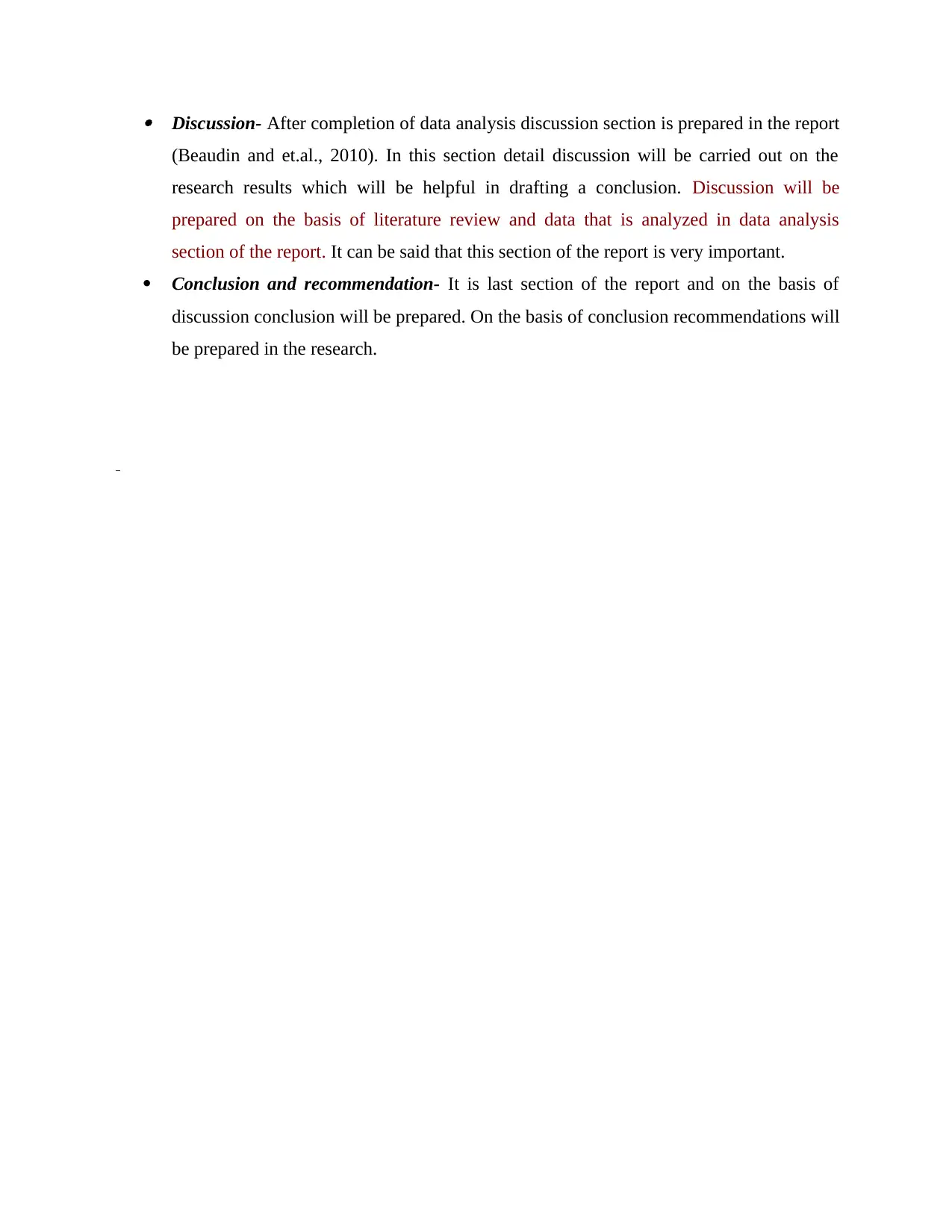
Discussion- After completion of data analysis discussion section is prepared in the report
(Beaudin and et.al., 2010). In this section detail discussion will be carried out on the
research results which will be helpful in drafting a conclusion. Discussion will be
prepared on the basis of literature review and data that is analyzed in data analysis
section of the report. It can be said that this section of the report is very important.
Conclusion and recommendation- It is last section of the report and on the basis of
discussion conclusion will be prepared. On the basis of conclusion recommendations will
be prepared in the research.
(Beaudin and et.al., 2010). In this section detail discussion will be carried out on the
research results which will be helpful in drafting a conclusion. Discussion will be
prepared on the basis of literature review and data that is analyzed in data analysis
section of the report. It can be said that this section of the report is very important.
Conclusion and recommendation- It is last section of the report and on the basis of
discussion conclusion will be prepared. On the basis of conclusion recommendations will
be prepared in the research.
⊘ This is a preview!⊘
Do you want full access?
Subscribe today to unlock all pages.

Trusted by 1+ million students worldwide
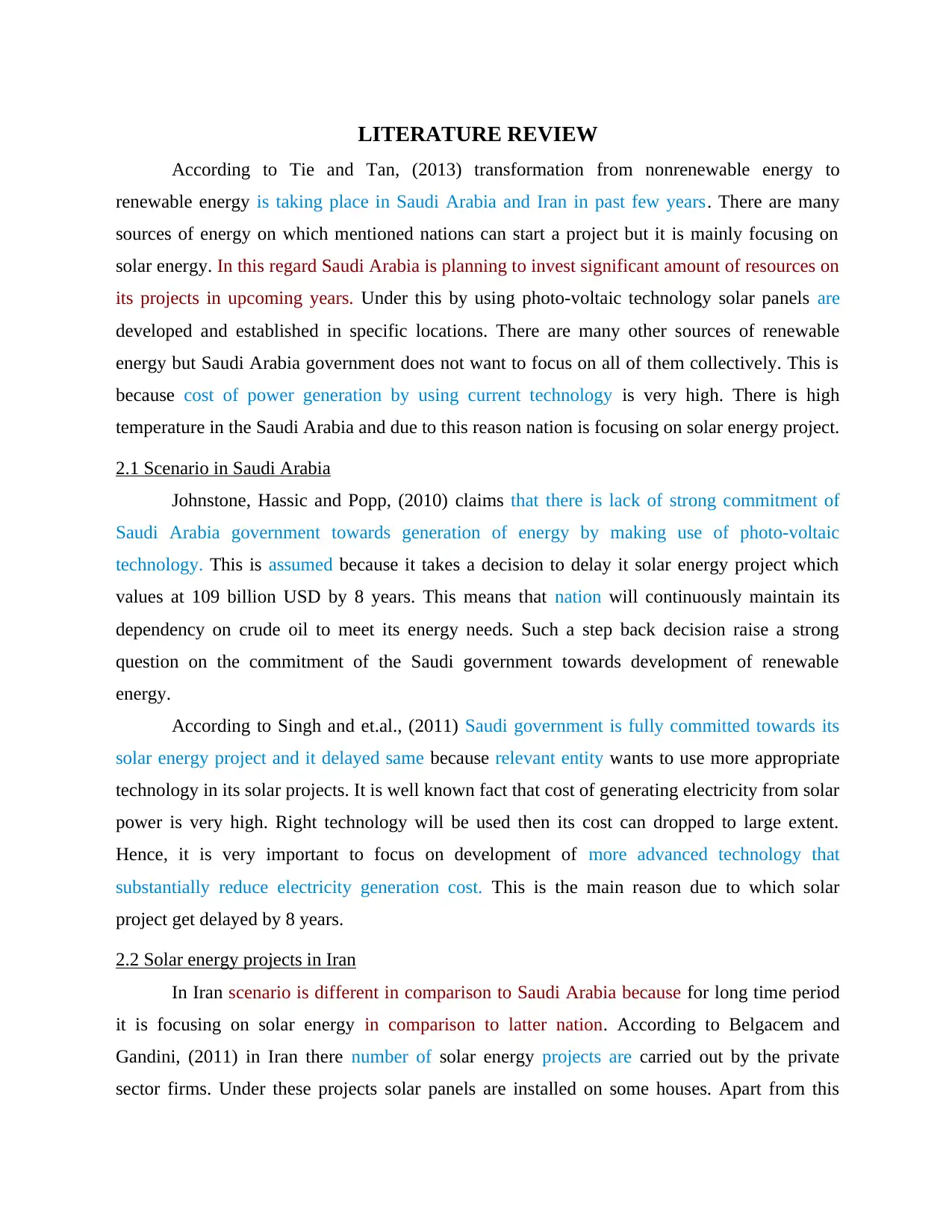
LITERATURE REVIEW
According to Tie and Tan, (2013) transformation from nonrenewable energy to
renewable energy is taking place in Saudi Arabia and Iran in past few years. There are many
sources of energy on which mentioned nations can start a project but it is mainly focusing on
solar energy. In this regard Saudi Arabia is planning to invest significant amount of resources on
its projects in upcoming years. Under this by using photo-voltaic technology solar panels are
developed and established in specific locations. There are many other sources of renewable
energy but Saudi Arabia government does not want to focus on all of them collectively. This is
because cost of power generation by using current technology is very high. There is high
temperature in the Saudi Arabia and due to this reason nation is focusing on solar energy project.
2.1 Scenario in Saudi Arabia
Johnstone, Hassic and Popp, (2010) claims that there is lack of strong commitment of
Saudi Arabia government towards generation of energy by making use of photo-voltaic
technology. This is assumed because it takes a decision to delay it solar energy project which
values at 109 billion USD by 8 years. This means that nation will continuously maintain its
dependency on crude oil to meet its energy needs. Such a step back decision raise a strong
question on the commitment of the Saudi government towards development of renewable
energy.
According to Singh and et.al., (2011) Saudi government is fully committed towards its
solar energy project and it delayed same because relevant entity wants to use more appropriate
technology in its solar projects. It is well known fact that cost of generating electricity from solar
power is very high. Right technology will be used then its cost can dropped to large extent.
Hence, it is very important to focus on development of more advanced technology that
substantially reduce electricity generation cost. This is the main reason due to which solar
project get delayed by 8 years.
2.2 Solar energy projects in Iran
In Iran scenario is different in comparison to Saudi Arabia because for long time period
it is focusing on solar energy in comparison to latter nation. According to Belgacem and
Gandini, (2011) in Iran there number of solar energy projects are carried out by the private
sector firms. Under these projects solar panels are installed on some houses. Apart from this
According to Tie and Tan, (2013) transformation from nonrenewable energy to
renewable energy is taking place in Saudi Arabia and Iran in past few years. There are many
sources of energy on which mentioned nations can start a project but it is mainly focusing on
solar energy. In this regard Saudi Arabia is planning to invest significant amount of resources on
its projects in upcoming years. Under this by using photo-voltaic technology solar panels are
developed and established in specific locations. There are many other sources of renewable
energy but Saudi Arabia government does not want to focus on all of them collectively. This is
because cost of power generation by using current technology is very high. There is high
temperature in the Saudi Arabia and due to this reason nation is focusing on solar energy project.
2.1 Scenario in Saudi Arabia
Johnstone, Hassic and Popp, (2010) claims that there is lack of strong commitment of
Saudi Arabia government towards generation of energy by making use of photo-voltaic
technology. This is assumed because it takes a decision to delay it solar energy project which
values at 109 billion USD by 8 years. This means that nation will continuously maintain its
dependency on crude oil to meet its energy needs. Such a step back decision raise a strong
question on the commitment of the Saudi government towards development of renewable
energy.
According to Singh and et.al., (2011) Saudi government is fully committed towards its
solar energy project and it delayed same because relevant entity wants to use more appropriate
technology in its solar projects. It is well known fact that cost of generating electricity from solar
power is very high. Right technology will be used then its cost can dropped to large extent.
Hence, it is very important to focus on development of more advanced technology that
substantially reduce electricity generation cost. This is the main reason due to which solar
project get delayed by 8 years.
2.2 Solar energy projects in Iran
In Iran scenario is different in comparison to Saudi Arabia because for long time period
it is focusing on solar energy in comparison to latter nation. According to Belgacem and
Gandini, (2011) in Iran there number of solar energy projects are carried out by the private
sector firms. Under these projects solar panels are installed on some houses. Apart from this
Paraphrase This Document
Need a fresh take? Get an instant paraphrase of this document with our AI Paraphraser
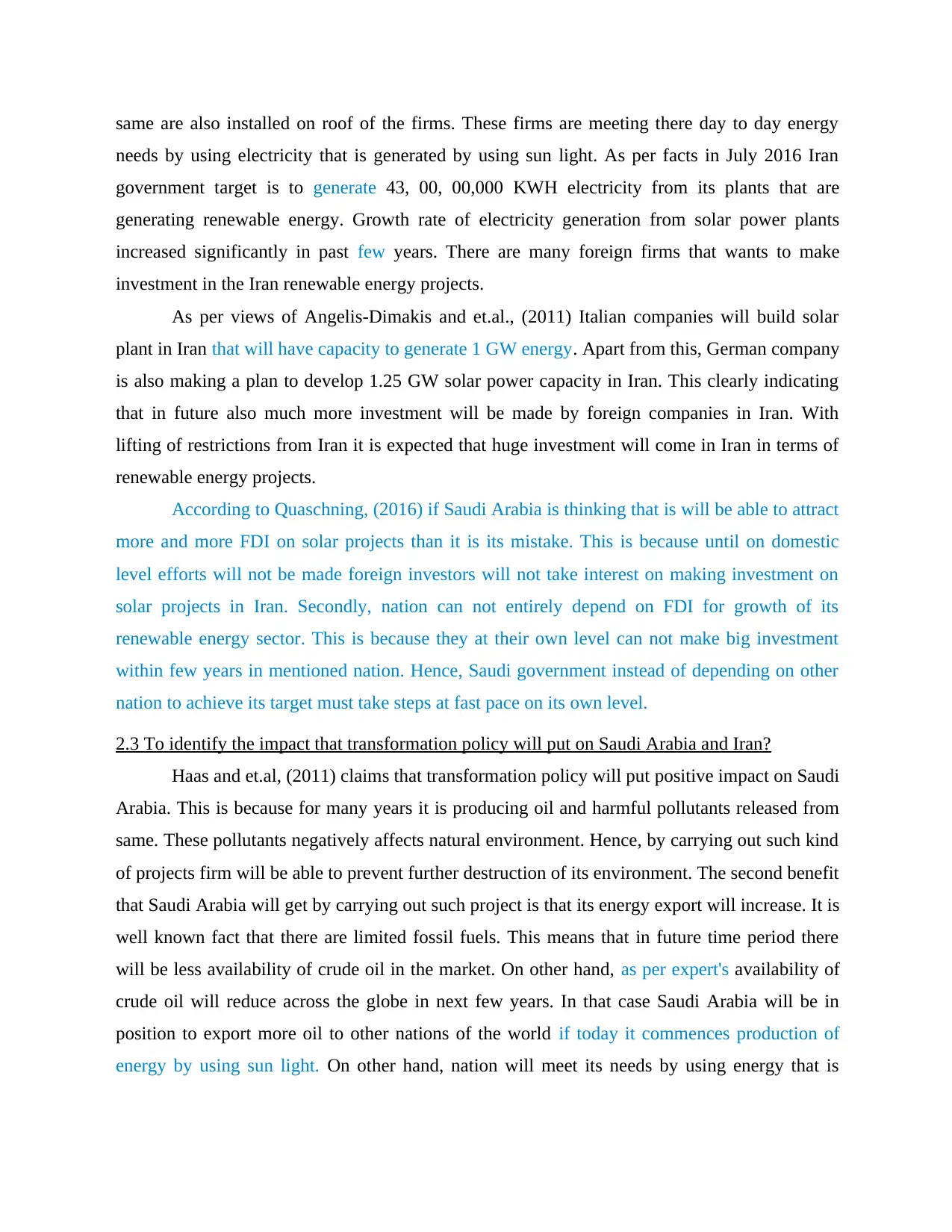
same are also installed on roof of the firms. These firms are meeting there day to day energy
needs by using electricity that is generated by using sun light. As per facts in July 2016 Iran
government target is to generate 43, 00, 00,000 KWH electricity from its plants that are
generating renewable energy. Growth rate of electricity generation from solar power plants
increased significantly in past few years. There are many foreign firms that wants to make
investment in the Iran renewable energy projects.
As per views of Angelis-Dimakis and et.al., (2011) Italian companies will build solar
plant in Iran that will have capacity to generate 1 GW energy. Apart from this, German company
is also making a plan to develop 1.25 GW solar power capacity in Iran. This clearly indicating
that in future also much more investment will be made by foreign companies in Iran. With
lifting of restrictions from Iran it is expected that huge investment will come in Iran in terms of
renewable energy projects.
According to Quaschning, (2016) if Saudi Arabia is thinking that is will be able to attract
more and more FDI on solar projects than it is its mistake. This is because until on domestic
level efforts will not be made foreign investors will not take interest on making investment on
solar projects in Iran. Secondly, nation can not entirely depend on FDI for growth of its
renewable energy sector. This is because they at their own level can not make big investment
within few years in mentioned nation. Hence, Saudi government instead of depending on other
nation to achieve its target must take steps at fast pace on its own level.
2.3 To identify the impact that transformation policy will put on Saudi Arabia and Iran?
Haas and et.al, (2011) claims that transformation policy will put positive impact on Saudi
Arabia. This is because for many years it is producing oil and harmful pollutants released from
same. These pollutants negatively affects natural environment. Hence, by carrying out such kind
of projects firm will be able to prevent further destruction of its environment. The second benefit
that Saudi Arabia will get by carrying out such project is that its energy export will increase. It is
well known fact that there are limited fossil fuels. This means that in future time period there
will be less availability of crude oil in the market. On other hand, as per expert's availability of
crude oil will reduce across the globe in next few years. In that case Saudi Arabia will be in
position to export more oil to other nations of the world if today it commences production of
energy by using sun light. On other hand, nation will meet its needs by using energy that is
needs by using electricity that is generated by using sun light. As per facts in July 2016 Iran
government target is to generate 43, 00, 00,000 KWH electricity from its plants that are
generating renewable energy. Growth rate of electricity generation from solar power plants
increased significantly in past few years. There are many foreign firms that wants to make
investment in the Iran renewable energy projects.
As per views of Angelis-Dimakis and et.al., (2011) Italian companies will build solar
plant in Iran that will have capacity to generate 1 GW energy. Apart from this, German company
is also making a plan to develop 1.25 GW solar power capacity in Iran. This clearly indicating
that in future also much more investment will be made by foreign companies in Iran. With
lifting of restrictions from Iran it is expected that huge investment will come in Iran in terms of
renewable energy projects.
According to Quaschning, (2016) if Saudi Arabia is thinking that is will be able to attract
more and more FDI on solar projects than it is its mistake. This is because until on domestic
level efforts will not be made foreign investors will not take interest on making investment on
solar projects in Iran. Secondly, nation can not entirely depend on FDI for growth of its
renewable energy sector. This is because they at their own level can not make big investment
within few years in mentioned nation. Hence, Saudi government instead of depending on other
nation to achieve its target must take steps at fast pace on its own level.
2.3 To identify the impact that transformation policy will put on Saudi Arabia and Iran?
Haas and et.al, (2011) claims that transformation policy will put positive impact on Saudi
Arabia. This is because for many years it is producing oil and harmful pollutants released from
same. These pollutants negatively affects natural environment. Hence, by carrying out such kind
of projects firm will be able to prevent further destruction of its environment. The second benefit
that Saudi Arabia will get by carrying out such project is that its energy export will increase. It is
well known fact that there are limited fossil fuels. This means that in future time period there
will be less availability of crude oil in the market. On other hand, as per expert's availability of
crude oil will reduce across the globe in next few years. In that case Saudi Arabia will be in
position to export more oil to other nations of the world if today it commences production of
energy by using sun light. On other hand, nation will meet its needs by using energy that is
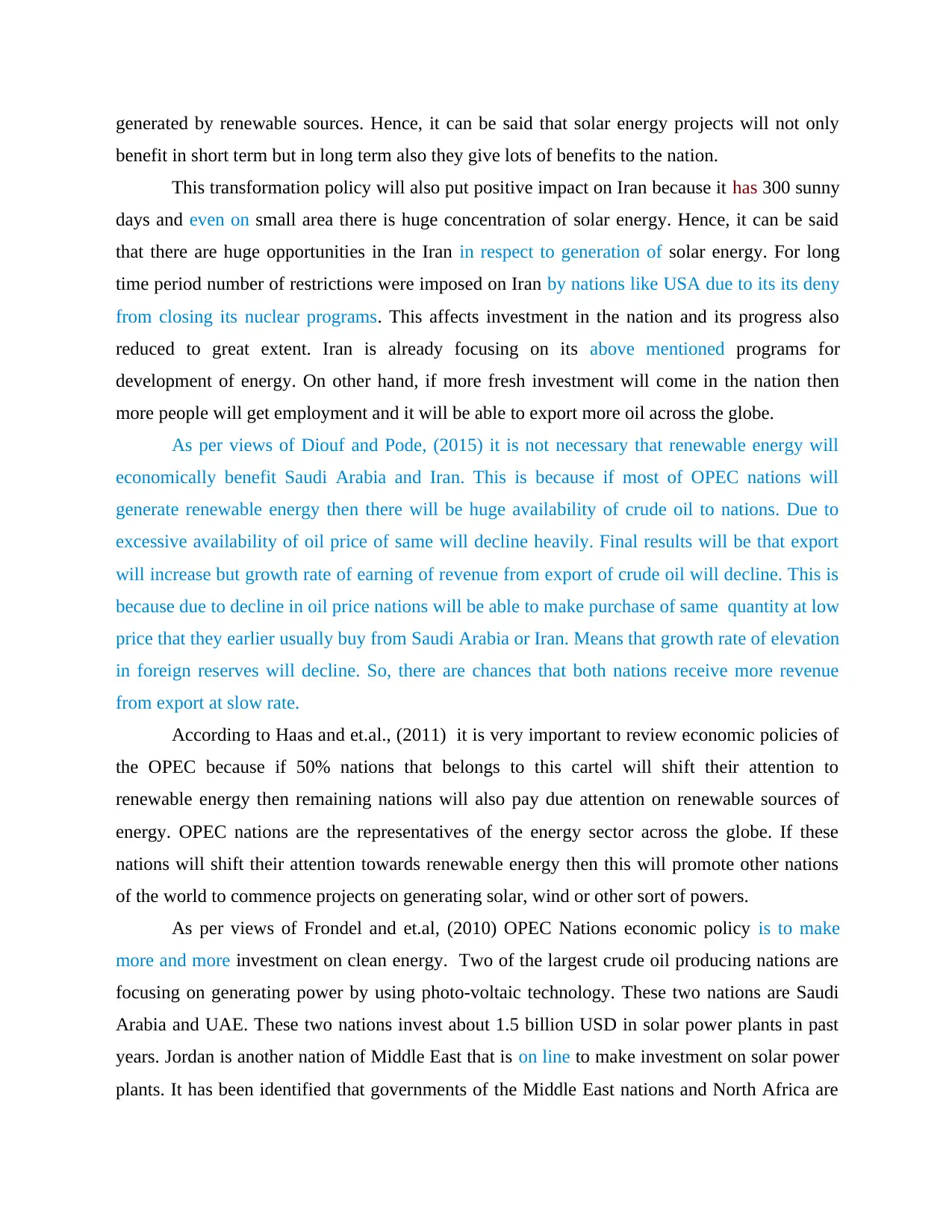
generated by renewable sources. Hence, it can be said that solar energy projects will not only
benefit in short term but in long term also they give lots of benefits to the nation.
This transformation policy will also put positive impact on Iran because it has 300 sunny
days and even on small area there is huge concentration of solar energy. Hence, it can be said
that there are huge opportunities in the Iran in respect to generation of solar energy. For long
time period number of restrictions were imposed on Iran by nations like USA due to its its deny
from closing its nuclear programs. This affects investment in the nation and its progress also
reduced to great extent. Iran is already focusing on its above mentioned programs for
development of energy. On other hand, if more fresh investment will come in the nation then
more people will get employment and it will be able to export more oil across the globe.
As per views of Diouf and Pode, (2015) it is not necessary that renewable energy will
economically benefit Saudi Arabia and Iran. This is because if most of OPEC nations will
generate renewable energy then there will be huge availability of crude oil to nations. Due to
excessive availability of oil price of same will decline heavily. Final results will be that export
will increase but growth rate of earning of revenue from export of crude oil will decline. This is
because due to decline in oil price nations will be able to make purchase of same quantity at low
price that they earlier usually buy from Saudi Arabia or Iran. Means that growth rate of elevation
in foreign reserves will decline. So, there are chances that both nations receive more revenue
from export at slow rate.
According to Haas and et.al., (2011) it is very important to review economic policies of
the OPEC because if 50% nations that belongs to this cartel will shift their attention to
renewable energy then remaining nations will also pay due attention on renewable sources of
energy. OPEC nations are the representatives of the energy sector across the globe. If these
nations will shift their attention towards renewable energy then this will promote other nations
of the world to commence projects on generating solar, wind or other sort of powers.
As per views of Frondel and et.al, (2010) OPEC Nations economic policy is to make
more and more investment on clean energy. Two of the largest crude oil producing nations are
focusing on generating power by using photo-voltaic technology. These two nations are Saudi
Arabia and UAE. These two nations invest about 1.5 billion USD in solar power plants in past
years. Jordan is another nation of Middle East that is on line to make investment on solar power
plants. It has been identified that governments of the Middle East nations and North Africa are
benefit in short term but in long term also they give lots of benefits to the nation.
This transformation policy will also put positive impact on Iran because it has 300 sunny
days and even on small area there is huge concentration of solar energy. Hence, it can be said
that there are huge opportunities in the Iran in respect to generation of solar energy. For long
time period number of restrictions were imposed on Iran by nations like USA due to its its deny
from closing its nuclear programs. This affects investment in the nation and its progress also
reduced to great extent. Iran is already focusing on its above mentioned programs for
development of energy. On other hand, if more fresh investment will come in the nation then
more people will get employment and it will be able to export more oil across the globe.
As per views of Diouf and Pode, (2015) it is not necessary that renewable energy will
economically benefit Saudi Arabia and Iran. This is because if most of OPEC nations will
generate renewable energy then there will be huge availability of crude oil to nations. Due to
excessive availability of oil price of same will decline heavily. Final results will be that export
will increase but growth rate of earning of revenue from export of crude oil will decline. This is
because due to decline in oil price nations will be able to make purchase of same quantity at low
price that they earlier usually buy from Saudi Arabia or Iran. Means that growth rate of elevation
in foreign reserves will decline. So, there are chances that both nations receive more revenue
from export at slow rate.
According to Haas and et.al., (2011) it is very important to review economic policies of
the OPEC because if 50% nations that belongs to this cartel will shift their attention to
renewable energy then remaining nations will also pay due attention on renewable sources of
energy. OPEC nations are the representatives of the energy sector across the globe. If these
nations will shift their attention towards renewable energy then this will promote other nations
of the world to commence projects on generating solar, wind or other sort of powers.
As per views of Frondel and et.al, (2010) OPEC Nations economic policy is to make
more and more investment on clean energy. Two of the largest crude oil producing nations are
focusing on generating power by using photo-voltaic technology. These two nations are Saudi
Arabia and UAE. These two nations invest about 1.5 billion USD in solar power plants in past
years. Jordan is another nation of Middle East that is on line to make investment on solar power
plants. It has been identified that governments of the Middle East nations and North Africa are
⊘ This is a preview!⊘
Do you want full access?
Subscribe today to unlock all pages.

Trusted by 1+ million students worldwide
1 out of 40
Related Documents
Your All-in-One AI-Powered Toolkit for Academic Success.
+13062052269
info@desklib.com
Available 24*7 on WhatsApp / Email
![[object Object]](/_next/static/media/star-bottom.7253800d.svg)
Unlock your academic potential
Copyright © 2020–2025 A2Z Services. All Rights Reserved. Developed and managed by ZUCOL.





